At the heart of every successful construction venture are construction contracts. Since they ensure construction workers receive their dues on time, it’s important not to underestimate their importance. In the intricate dance of construction, where creativity meets bricks and beams, understanding how to navigate payment difficulties is crucial for a successful journey from the blueprint to reality.
Yet, even in the most highly-organized projects, challenges may arise, resulting in potential payment disputes. This guide aims to equip you with the insights needed to handle such situations, transforming potential conflicts into swift and effective resolutions.
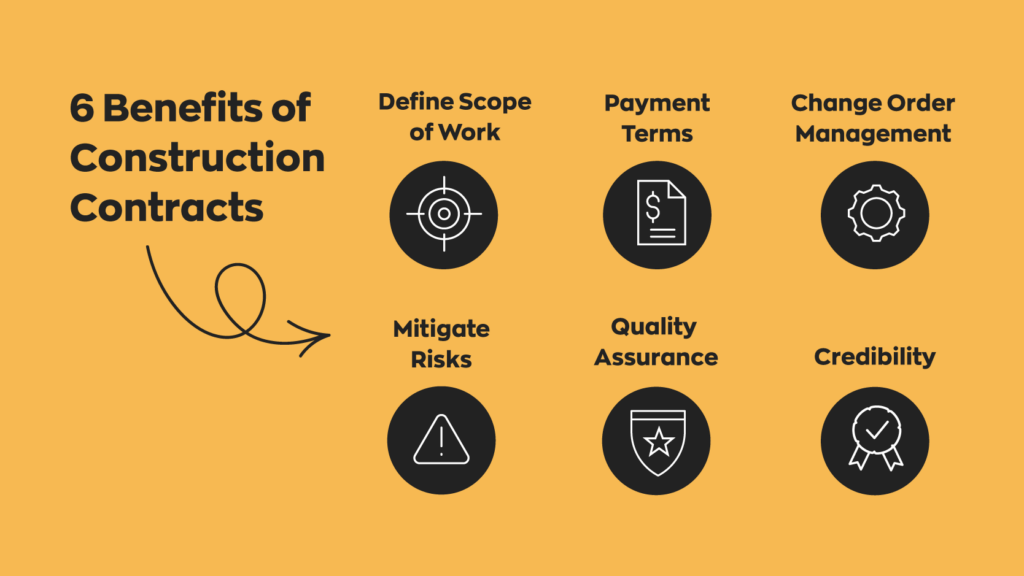
So, whether you’re a seasoned contractor looking for ways to optimize your payment terms or a newbie just dipping your toes into the construction world, this guide is for you.
Construction payment structures
Imagine payment structures as the blueprint of your project’s financial side. They determine who gets what, then how and when payments are made throughout the project. Therefore choosing the right payment structure isn’t just a step to check off; it’s a strategic move that affects how smoothly everything runs.
Three primary payment structures take center stage:
- upfront payments,
- milestone-based payments, and
- completion-based payments.
Upfront payments
Upfront payments act as the project’s ignition key. Just as a car requires fuel to start its journey, an upfront payment ensures that both parties are committed to the project from the start.
To demonstrate, let’s take as an example a small home contracting business tasked with building a deck for an agreed contract price of $5,000. Without a doubt, in this scenario, upfront payments would be the best (and most pragmatic) solution to balance financial aspects for both parties involved.
To kick things off, the contractor asks for $2,500 upfront. Such an initial payment has a dual purpose:
- to get vital permissions required for the project’s legality, and
- to cover the price of procuring crucial supplies.
The remaining $2,500, paid later, covers the rest of the materials, the contractor’s profit, and labor costs.
This way, the contractor doesn’t have the burden of procuring all necessary materials right away. At the same time, the homeowner retains a degree of control by withholding the final payment until project completion. It’s a win-win, really, helping both sides manage the project and payments smoothly.
Milestone-based payments
Milestone-based payments function like progress markers. Think of them as checkpoints along the project’s roadmap. Payments are triggered once the contractor reaches each milestone — whether completing a project phase or obtaining necessary approvals. Hence, this payment structure ensures that compensation directly ties to tangible progress.
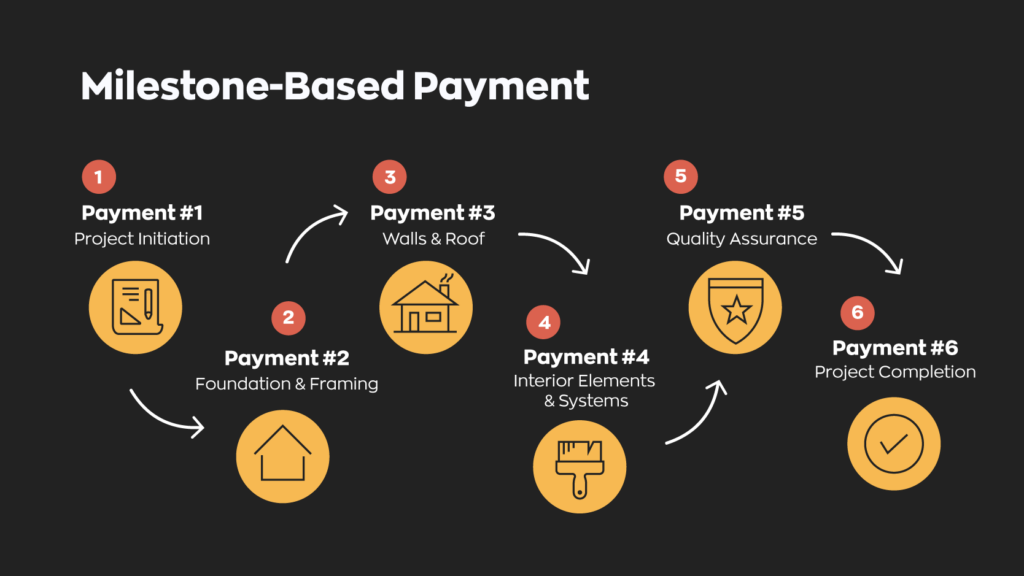
For instance, consider a construction company hired to build a modern office building. The total contract price for such a project is $1 million. Here’s what milestones for payment this project might have:
Milestone 1: Project initiation and foundation
The first milestone is quite similar to the upfront payments. Upon obtaining the necessary permits and commencing the project, the contractor receives an initial payment of $150,000. This milestone covers the groundwork, foundation, and initial site preparation.
Milestone 2: Structural completion
The next milestone payment (for example, $300,000) is triggered once the building is erected as planned and verified as per architectural plans. This stage encompasses the construction of floors, walls, and the roof.
Milestone 3: Interior fit-out and systems installation
After securing the building’s structure, the focus shifts to interior elements and systems installation. This phase includes electrical, plumbing, HVAC, and interior design. Upon completion, the contractor receives a payment of $250,000 to cover materials procurement and labor costs needed.
Milestone 4: Finalization and quality assurance
The contractor must make sure all components are operating fully and continuously as the project draws to a close. The quality checks and system ensure the excellent execution of all earlier steps. At this point, the final touch-ups are feasible. The client releases a payment of $200,000 as a sign of mutual satisfaction with the project’s progress.
Milestone 5: Project completion and handover
The final milestone signifies project completion and successful handover to the client. After final inspections and necessary documentation are complete, the construction company will receive the remaining balance of $100,000.
Completion-based payments
Lastly, completion-based payments take the spotlight as the project wraps up successfully. This strategy, however, might be risky for contractors. Unlike other payment schemes, completion-based payments lack assurance procedures, leaving contractors susceptible.
First of all, contractors must cover significant upfront costs for materials and permissions that are likely to strain their finances. Secondly, contractors can easily fall victim to scope creep, especially when there are no mechanisms in place to limit requests for improvements or corrections by the customer.
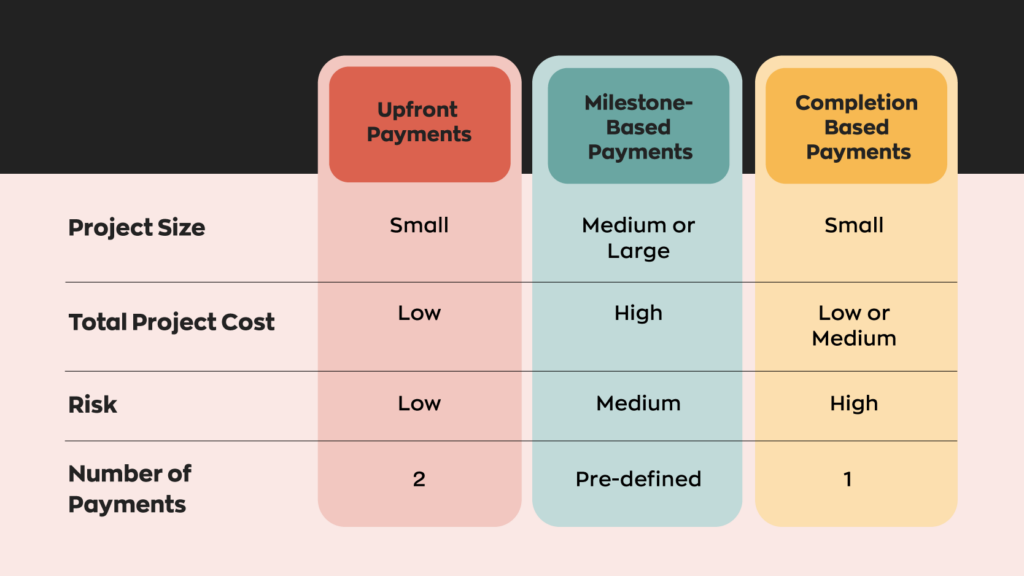
Payment term negotiation strategies for contractors
In most cases, independent construction contractors feel they take a weaker position in the negotiations. Such an approach puts a thriving business at risk, as securing fair compensation is paramount for independent contractors.
Confidently present your case, employing active listening to understand the client’s vision and articulating your contributions. If you want to be in a position of power, initial preparation is a must. You can add credibility to your professional approach while presenting and offering the following:
- a thorough comprehension of the project requirements and needs,
- a confidence in being able to fulfill them,
- an understanding of fork prices and rates on the market, and
- a unique value proposition you can offer that differs from the competitors.
Don’t forget to back your proposal with data-driven insights. So that you can support your claims and avoid being unsubstantiated in case the client has any requests for clarification. For instance, in a recent Bureau of Labor Statistics study, the 2021 median wage for construction managers was $98,890 per year. Citing such trustworthy sources gives your perspective in negotiations more weight.
Payment terms from the client’s perspective
On the other hand, clients that work on construction cases with independent contractors must balance budgets to ensure fair pay. And, again, what could be better than market research?
For instance, according to some experts your construction labor cost percentage should be anywhere from 20% to 40% of total costs. This knowledge enables customers to design pay packages consistent with industry standards, promoting cooperation between parties.
Striking a balance
Fruitful payment terms for both parties rely on transparent negotiations. Parties must outline work scope, project timelines, and expectations distinctly. Such an approach will help contractors provide accurate quotes and set the stage for realistic expectations.
Clarity and transparency are especially important when purchasing materials and tools needed for construction, keeping them in stock, and streamlining all the connected processes. For efficient inventory management, software like inFlow gives you the tool for placing purchase orders or setting reorder points, which will prevent you from running out of materials. That saves money (and nerves) for both parties. It even synchronizes with your bookkeeping tools like QuickBooks Online and Xero. With inFlow, there’s no more need for “guesstimates” anymore. Instead, you can rely on good data to ensure a clear business perspective.
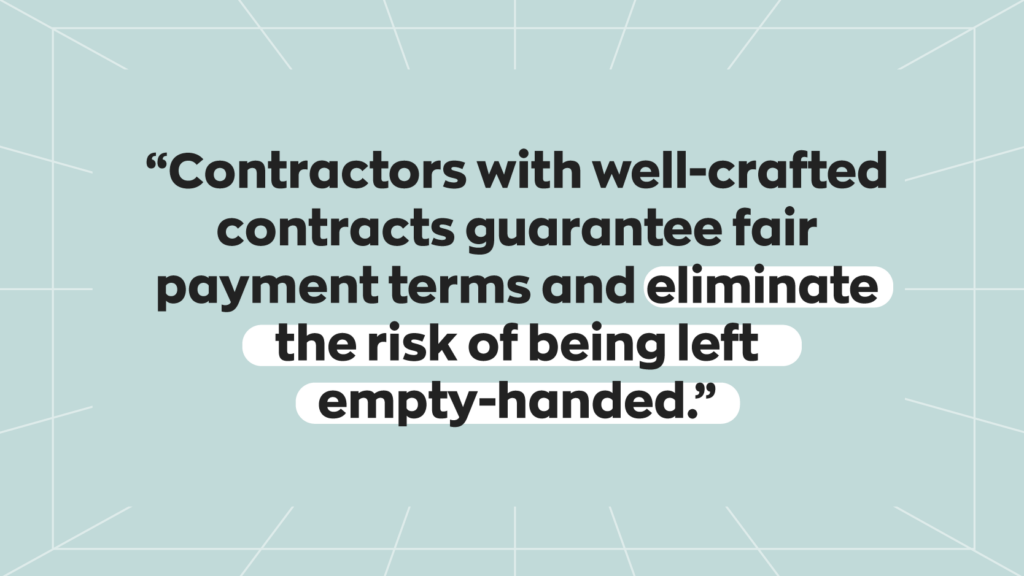
Legal considerations for equitable compensation
The world of construction is a mix of challenges and responsibilities, including some important legal and ethical considerations:
- Safety takes center stage — it’s like the guardian of construction. Building sites can be risky zones, so bosses need to ensure everyone is following safety rules. This means proper training, gear, and a hazard-free environment. Ignoring safety rules can lead to more than just scraped knees.
- Then comes the rulebook from the government. Every construction project has to follow laws from the local, state, and national levels. Breaking these rules can lead to severe fines and other problems. Even the most minor rule slip-ups can cause a lot of headaches.
- Last but not least, the side characters — subcontractors — have their own script to follow. Just like actors have roles to play, subcontractors need licenses and insurance. They also have to treat their crew fairly, with things like decent wages and equal treatment.
Labor and safety standards
In the construction industry, the principle of fair compensation is intricately tied to the safety conditions under which workers operate. Particularly in regions with challenging environmental or weather factors, such as Texas’s harsh weather conditions, fair compensation becomes crucial to acknowledge workers’ risks.
According to a report issued by the U.S. Bureau of Labor Statistics, Texas has the greatest occupational fatalities among construction workers. The BLS figures show that in the state’s construction industry, for every 100,000 employees in 2010, there were 10.7 deaths.
In order to alleviate these worries, progressive construction firms in Texas have introduced hazard pay, a method that adds to workers’ compensation to reflect the elevated risks they face.
Contracts & liability
Contracts and liability are two major focuses when discussing legal and moral issues in the building sector. A clear contract is the cornerstone of any successful construction project. Things that you should describe in these contracts include:
- Obligations
- Privileges
- Working conditions
- Liabilities
A written agreement acts as a safety net in the event of difficulties by requiring both parties to respect their agreed-upon obligations.
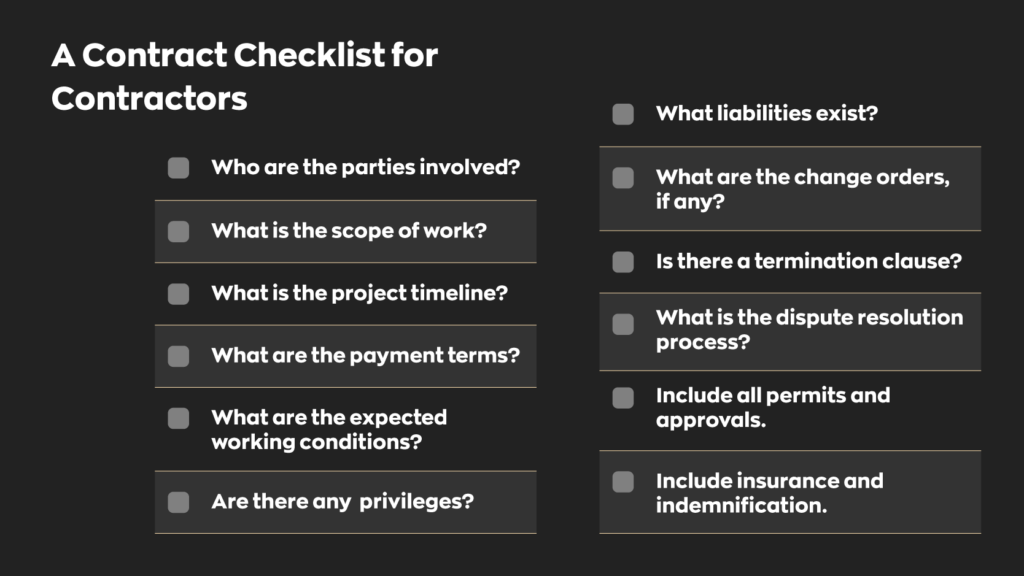
For a practical illustration of a well-constructed agreement, consider utilizing a professionally designed Independent Contractor Agreement template. Being professionally reviewed by legal experts, this template will allow you to enhance the clarity of construction contractors-clients relationships, ensuring their reliability and suitability for protecting both parties.
Regulatory compliance in construction
Navigating the construction sector in the United States entails following state rules and compliance criteria. To ensure compliance with state-specific building rules, safety recommendations, licensing requirements, construction liens laws, and insurance and bonding, it is critical to contact an expert US attorney. The following are some instances of how state regulations may differ:
- For instance, according to the New York Lien Law, a mechanic’s lien must be filed within eight months from the last day of work or the provision of materials on a project. Such a requirement means that construction contractors must be vigilant about tracking their work schedule. They must ensure the filing of the mechanic’s lien within the designated timeframe.
- As stated by the Alaska Department of Commerce, Community, and Economic Development, in Alaska, most contractors that perform residential home improvements must be licensed. And to get such a license, proof of current general liability insurance is required for registration (not less than $20,000 for property damage, $50,000 for injury, including death, to any one person, and $100,000 for injury, including death, to more than one person).
Navigating the road to fair compensation might present obstacles, but armed with knowledge, you can confidently steer through. As construction professionals, your expertise shapes skylines and transforms communities. Embracing fair compensation practices safeguards your interests and propels progress.






0 Comments